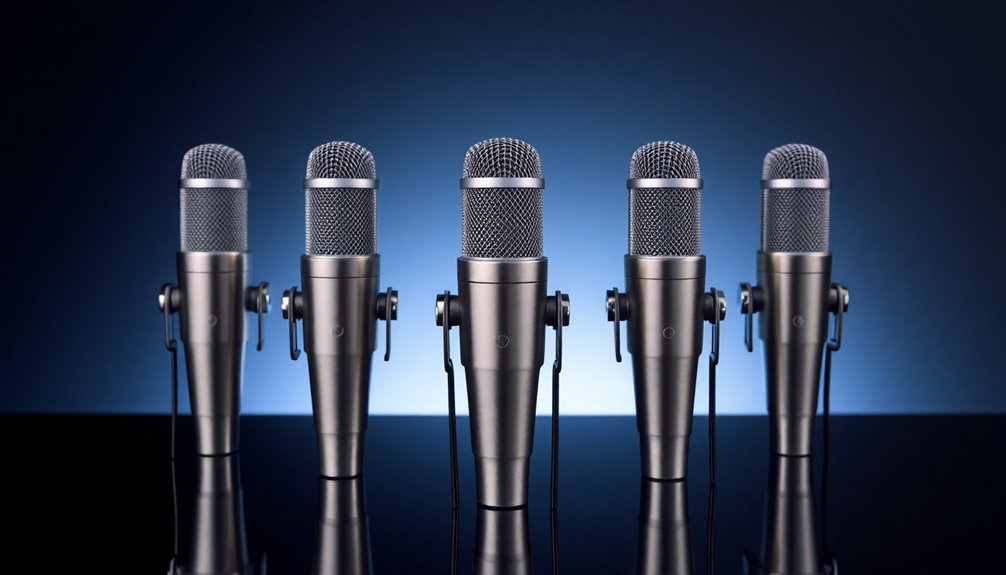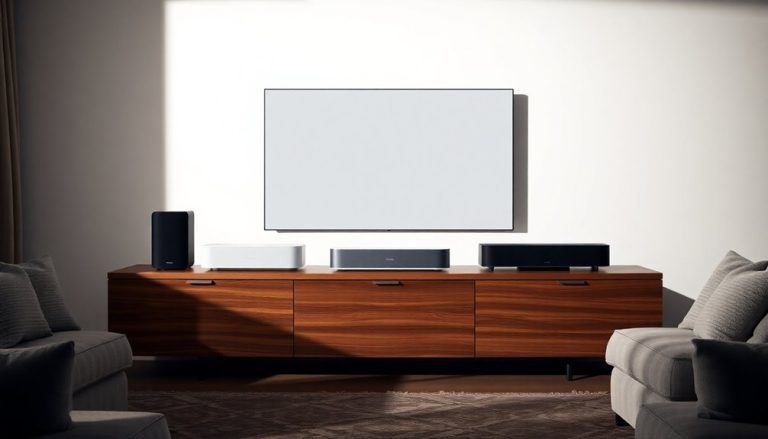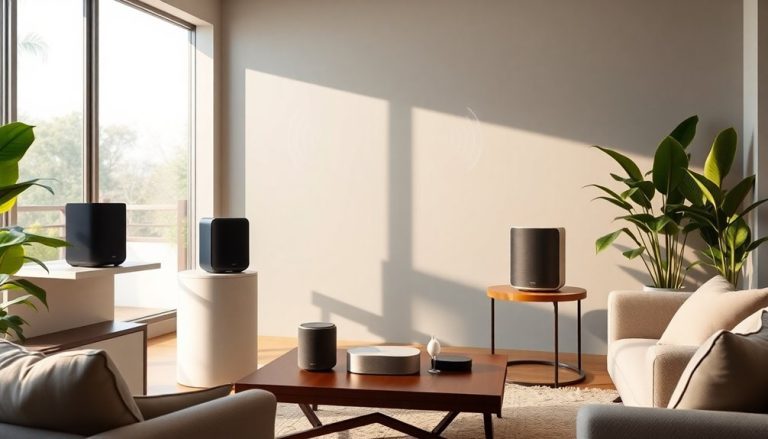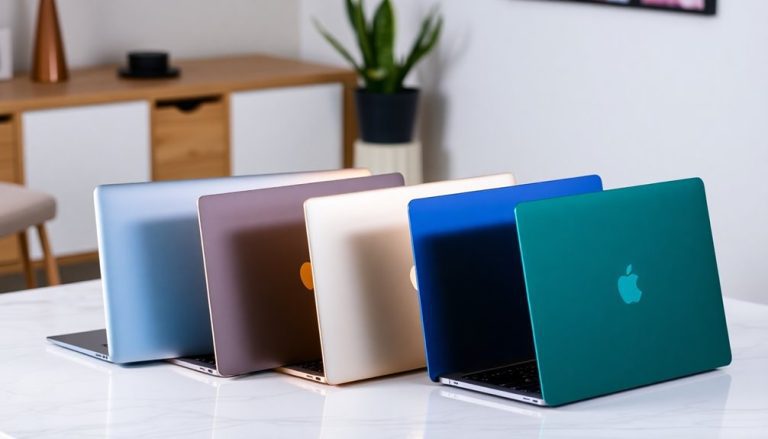In 2025, choosing the right vocal microphone can transform your sound quality and help you capture every nuance of your voice. Consider options like the Amazon Basics Wired Dynamic Microphone for affordability, or the Shure MV7+ for its advanced features and connectivity. The AUDIX OMX-T excels in noisy environments with its hypercardioid pattern, while the FIFINE K688 is perfect for podcasting. And don't forget the legendary Shure SM58, trusted by professionals worldwide. Each mic offers unique benefits, ensuring you'll find one that suits your needs. Keep going, and you'll discover even more details on these game-changing microphones.
Key Takeaways
- Dynamic Performance: Look for dynamic microphones with cardioid or hypercardioid patterns for effective vocal isolation and minimal background noise capture.
- Robust Build Quality: Choose microphones made from durable materials, like zinc die-cast housing, to withstand frequent use in various environments.
- Versatile Connectivity: Opt for microphones with XLR and USB options to ensure compatibility with both professional and digital recording setups.
- Budget Considerations: Consider models in the $100-$300 range, balancing performance features and affordability for serious vocal applications.
- Additional Features: Select microphones with essential accessories, monitoring jacks, and tap-to-mute functions for enhanced usability and convenience during recordings.
Amazon Basics Wired Dynamic Microphone for Singing and Speaking
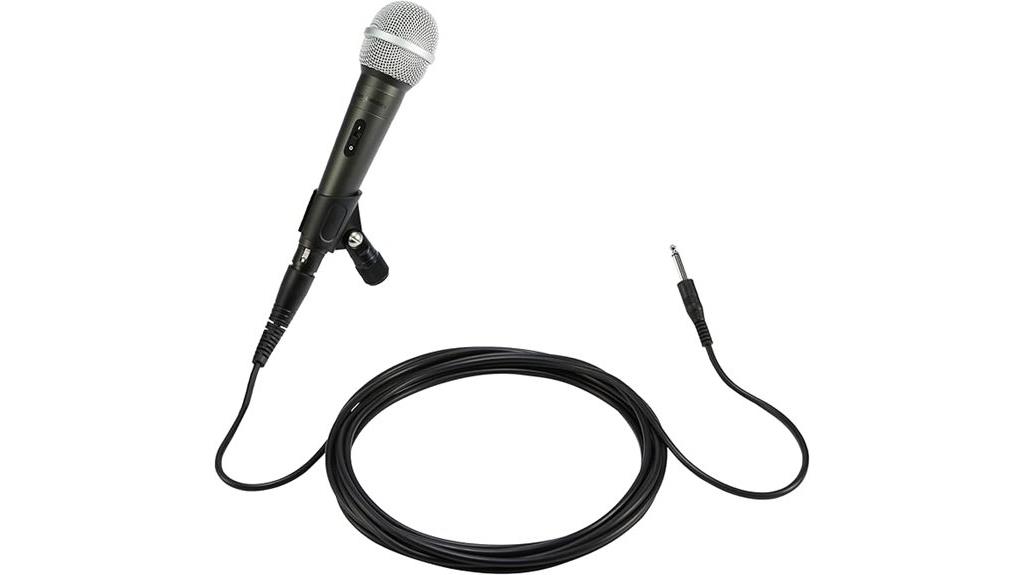
If you're looking for an affordable yet reliable microphone for singing or speaking, the Amazon Basics Wired Dynamic Microphone is a top choice. This dynamic vocal microphone features a cardioid pickup pattern that effectively isolates your voice, minimizing background noise and feedback. Weighing just 1.1 pounds, its zinc die-cast housing and steel mesh head ensure durability while maintaining a sleek black and silver design.
With XLR connectivity, setting it up is a breeze, and the built-in wind and pop filter guarantees clear sound reproduction. Customers rave about its vocal clarity, making it ideal for live performances, recordings, and even karaoke nights. While some users note a need for adequate power to avoid low volume, the overall value for the price is hard to beat.
Best For: Those seeking an affordable, high-quality microphone for live performances, recordings, or karaoke sessions.
Pros:
- Excellent vocal clarity due to the cardioid pickup pattern that minimizes background noise.
- Durable construction with zinc die-cast housing and steel mesh head.
- Easy setup with XLR connectivity and built-in wind and pop filter for clear sound reproduction.
Cons:
- Volume may be low without adequate power, requiring a good audio interface or mixer.
- Some users prefer a different cable type for enhanced audio quality.
- Limited warranty information may require customers to reach out for support.
Shure MV7+ Podcast Dynamic Microphone
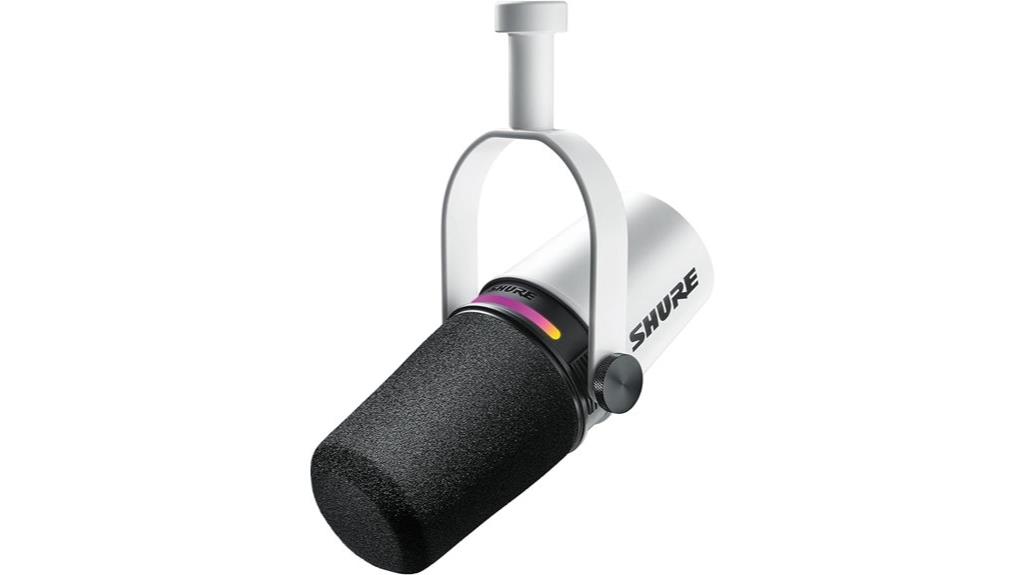
The Shure MV7+ Podcast Dynamic Microphone is perfect for podcasters and streamers who prioritize exceptional audio quality and user-friendly features. With its OBS certification, it seamlessly integrates with Open Broadcaster Software, ensuring top-tier audio. The Voice Isolation Technology and advanced DSP features deliver enhanced sound while the real-time denoiser eliminates background noise.
You'll appreciate the USB-C and XLR outputs, multi-color LED touch panel, and quick mute function. Its sturdy design and plug-and-play functionality make setup a breeze. Rated 4.7 out of 5 stars, users rave about its clarity and ease of use. At $249, it's a worthy investment for anyone serious about their audio quality. Just be aware of potential static noise in USB-C mode.
Best For: Podcasters and streamers who seek high-quality audio and user-friendly features for their content creation.
Pros:
- Plug-and-play functionality allows for easy setup and immediate recognition by computers and software.
- Excellent vocal clarity and effective noise cancellation enhance the overall audio experience.
- Multi-color LED touch panel provides customizable options and quick mute functionality.
Cons:
- Occasional static noise reported in USB-C mode, leading some users to prefer XLR connections.
- Touch interface responsiveness may not meet the preferences of all users, with some favoring physical controls.
- Price point of $249 may be seen as a significant investment for some potential buyers.
AUDIX OMX-T Dynamic Hypercardioid Vocal Microphone
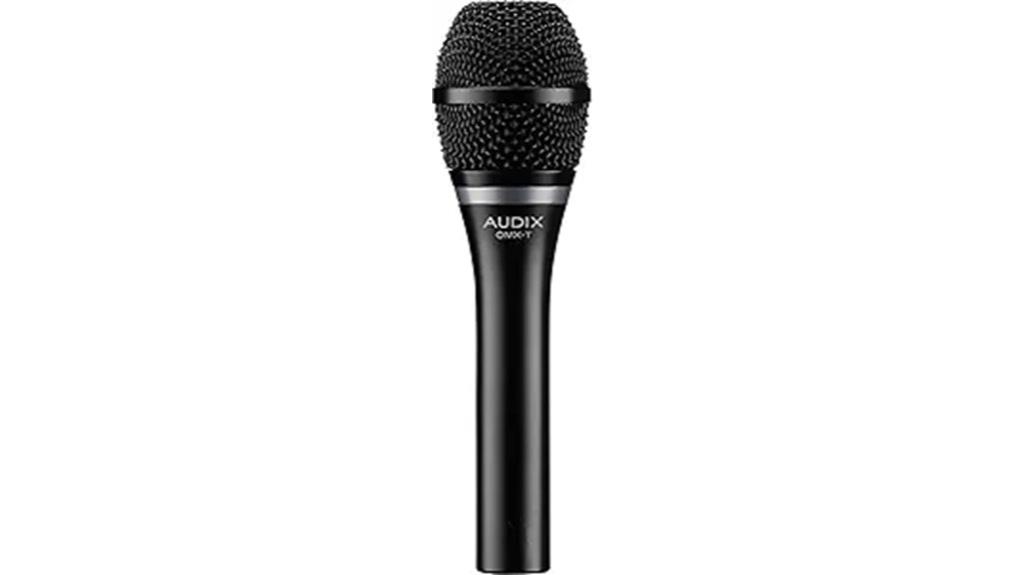
Designed for vocalists performing on loud stages, the AUDIX OMX-T Dynamic Hypercardioid Vocal Microphone excels in delivering clear sound while maintaining tight control over feedback. With a frequency range of 52Hz to 17kHz and an impressive max SPL of 144dB, you can confidently project your voice without distortion. Its rugged die-cast zinc alloy body and dent-resistant steel mesh grille ensure durability for frequent gigs and travel. Weighing only 15.8 ounces, it's easy to handle, and the included heavy-duty nylon clip and carrying pouch make transport a breeze. Crafted in the USA, the OMX-T promises exceptional performance with unprecedented gain before feedback, making it a top choice for any serious vocalist looking to shine on stage.
Best For: The AUDIX OMX-T Dynamic Hypercardioid Vocal Microphone is best for professional vocalists performing in loud environments who need clear sound and feedback control.
Pros:
- Exceptional gain before feedback allows for clear vocal projection on loud stages.
- Rugged construction with die-cast zinc alloy and dent-resistant grille ensures durability for frequent use.
- Lightweight design at 15.8 ounces, combined with included accessories, makes it easy to transport.
Cons:
- Limited frequency response range may not suit all vocal styles or instruments.
- Dynamic microphone may require more power or specific settings compared to condenser microphones.
- Lack of onboard settings or adjustments means users must rely on external equipment for sound customization.
FIFINE Dynamic Microphone for Podcast Recording (K688)
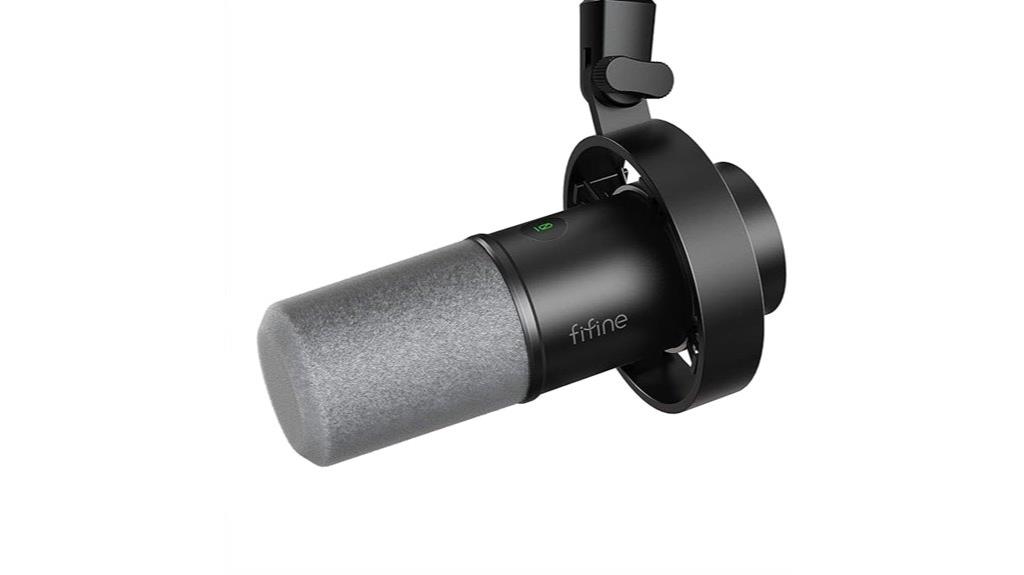
For podcasters and streamers seeking high-quality audio without the hassle, the FIFINE Dynamic Microphone (K688) stands out with its dual connectivity options—USB and XLR. With a cardioid pattern, it effectively reduces background noise, making it perfect for non-soundproof environments. You'll enjoy clean sound reproduction, thanks to its impressive signal-to-noise ratio exceeding 75dB and a frequency range of 50Hz-20KHz. The microphone features a tap-to-mute function, gain control, and a 3.5mm jack for real-time monitoring when using USB. Built with sturdy metal, it comes pre-mounted on a shock mount to minimize vibrations. Users appreciate its easy plug-and-play setup and excellent value, although some have encountered minor compatibility issues with specific USB ports.
Best For: Podcasters and streamers looking for a reliable and high-quality microphone that offers both USB and XLR connectivity options for versatile audio recording.
Pros:
- Dual connectivity (USB and XLR) for flexible usage in various setups.
- Excellent sound quality with a cardioid pattern that reduces background noise.
- Easy plug-and-play setup with a durable build and included accessories like a shock mount.
Cons:
- Some users report compatibility issues with specific USB ports, requiring reconnections or driver reinstalls.
- Careful positioning is necessary to avoid plosive sounds during recording.
- The weight and size may not be ideal for portable use or small setups.
Shure SM58 Pro XLR Dynamic Microphone
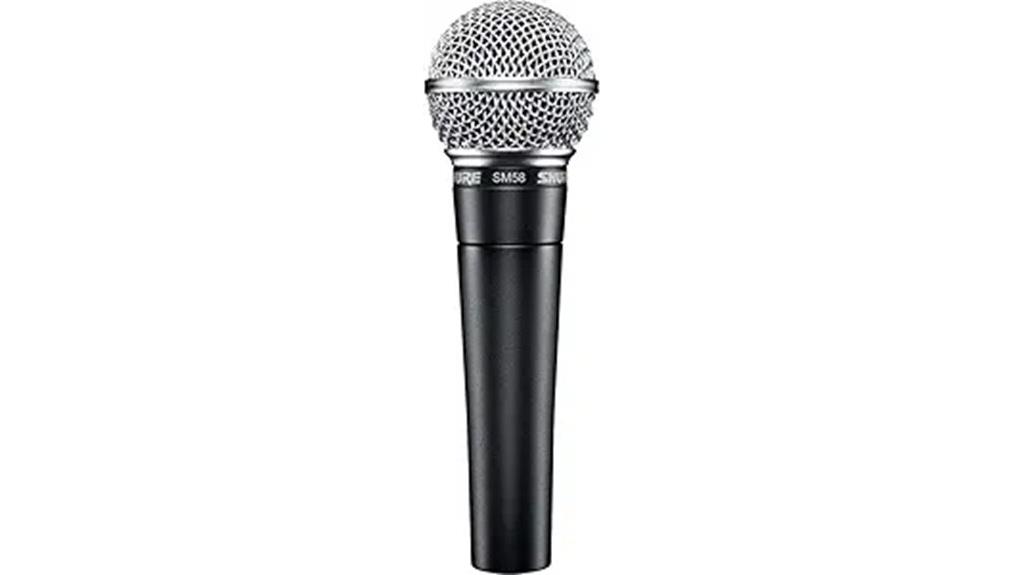
Often regarded as a staple in both live performances and studio settings, the Shure SM58 Pro XLR Dynamic Microphone is perfect for vocalists and podcasters alike. Weighing in at just 310 grams, it's both lightweight and durable, crafted from sturdy metal to withstand the rigors of the road. With a tailored frequency response and a uniform cardioid pattern, this mic delivers clear, warm vocals while effectively isolating unwanted background noise. Its spherical mesh grille and built-in pop filter further enhance sound quality. Rated 4.7 out of 5 stars, users praise its reliability and versatility. While it excels in live settings, keep in mind that you may need additional amplification for studio use.
Best For: Vocalists, podcasters, and live performers seeking a reliable and durable microphone for both studio and stage use.
Pros:
- Durable construction ensures longevity and withstands the demands of touring and live performances.
- Clear and warm vocal quality with effective isolation from background noise, making it ideal for various settings.
- High customer satisfaction with an average rating of 4.7 out of 5 stars, reflecting its popularity and reliability.
Cons:
- May require additional amplification for optimal performance in studio settings, particularly for detailed vocal recordings.
- Some users report reduced vocal detail compared to condenser microphones, which may not suit all recording needs.
- Not the best choice for untreated environments, as it may not capture the full clarity of vocals in such settings.
Factors to Consider When Choosing Vocal Microphones
When you're choosing a vocal microphone, you need to consider several key factors that can impact your sound quality. Think about the microphone type, polar pattern, and build quality, as these elements will affect how well it captures your voice. Don't forget to check the frequency response range and connectivity options to ensure it fits your setup.
Microphone Type Considerations
Choosing the right vocal microphone hinges on several critical factors that can significantly impact your performance. First, consider the microphone type. Dynamic microphones are often a great choice for live performances because they handle high sound levels well and have excellent gain before feedback. This makes them ideal for loud stages where clarity is essential.
Next, think about the pickup pattern. A cardioid microphone effectively isolates your voice while reducing background noise, which is crucial for vocal clarity. If you're in a particularly noisy environment, a hypercardioid microphone offers even tighter control over sound capture, ensuring your vocals shine through.
Frequency response also plays a vital role. For dynamic mics, a frequency range of 50 Hz to 15 kHz is common and can capture the nuances of your performance effectively. Lastly, durability and build quality shouldn't be overlooked. Choose a microphone designed for frequent use, featuring rugged construction that can withstand the rigors of live performances. By weighing these considerations, you'll be better equipped to select the microphone that best suits your vocal style and performance needs.
Polar Pattern Importance
The polar pattern of a microphone is a crucial factor in determining how well it captures your voice while minimizing unwanted noise. Understanding the different types of polar patterns—cardioid, hypercardioid, and omnidirectional—can significantly impact your recording experience.
Cardioid microphones are particularly effective for isolating your sound source, making them perfect for live performances and studio recordings. They pick up sound primarily from the front while reducing ambient noise from the sides and rear. If you require even tighter isolation, consider hypercardioid microphones. They have a narrower pickup pattern, capturing less sound from the sides but still allowing some rear audio, which can be useful in specific environments.
On the other hand, omnidirectional microphones capture sound equally from all directions. This can be beneficial when you want to include ambient noise, but be cautious—they may also pick up unwanted sounds in untreated spaces. By choosing the right polar pattern for your needs, you can achieve optimal audio clarity and reduce background noise, ensuring that your vocals shine whether you're performing live or recording in a less-than-ideal setting.
Build Quality Aspects
Evaluating the build quality of a microphone is essential for ensuring it can withstand the rigors of frequent use and transport. Look for models with durable materials, like zinc die-cast housing and steel mesh heads, which offer added protection. A rugged design featuring dent-resistant grilles and heavy-duty construction is vital, especially during live performances or when you're on the move.
Consider the weight of the microphone, as it can significantly impact your comfort and handling. Lighter models are often favored for handheld use, while heavier ones may indicate a more robust build. Microphones aimed at professionals typically incorporate premium materials, such as metal bodies, which enhance sound isolation and overall performance.
Don't overlook included accessories, either. Heavy-duty clips and carrying pouches can add significant value, making your microphone easier to transport and use in various environments. When you choose a microphone with solid build quality, you're investing in a reliable tool that will perform well under pressure and ensure your voice shines, no matter the setting. So, keep these factors in mind as you search for the perfect vocal microphone for your needs.
Frequency Response Range
How crucial is the frequency response range when selecting a vocal microphone? It's essential because this range indicates the spectrum of sound frequencies the microphone can capture, measured in Hertz (Hz). For most dynamic vocal microphones, a typical frequency response is between 50 Hz to 15 kHz, which effectively captures the majority of vocal tones. If you're aiming for a microphone that enhances audio detail, consider those with a wider frequency response. However, keep in mind that this is often more relevant for studio or specialized recordings.
When you're performing live, microphones with tailored frequency responses that emphasize midrange frequencies can significantly improve vocal clarity and presence. This is particularly beneficial in settings where you want your voice to stand out. Additionally, don't overlook the maximum sound pressure level (SPL) a microphone can handle, measured in decibels (dB). A microphone that can manage higher SPL without distortion will ensure your powerful vocals are captured beautifully. In summary, the frequency response range, along with SPL, plays a vital role in choosing the right vocal microphone for your needs.
Connectivity Options Available
When choosing a vocal microphone, considering connectivity options can significantly impact your setup and usage. Most vocal microphones come with XLR connectivity, which is preferred in professional audio setups. This option ensures balanced signal transmission and reduces interference, especially over longer distances. If you're looking for versatility, some microphones offer dual connectivity options like USB and XLR. This flexibility allows you to use the microphone in both digital and analog environments, making it ideal for applications ranging from podcasting to live performances.
Keep in mind that the type of cable you use can affect audio quality. For optimal performance in live sound situations, a balanced XLR cable is recommended to minimize interference. If you're setting up a home studio or doing casual recording, USB microphones provide easy plug-and-play functionality, eliminating the need for additional audio interfaces.
Additionally, some microphones feature a quick mute function via their connectivity interface. This feature enhances your user experience during live performances or recordings, allowing you to control sound output immediately. Ultimately, understanding these connectivity options will help you choose a microphone that best fits your needs.
Intended Use Cases
Choosing the right vocal microphone hinges on its intended use, whether you're performing live, recording in a studio, or streaming content. First, consider the microphone's polar pattern—cardioid or hypercardioid options are excellent for isolating your voice from background noise, making them ideal for both live performances and studio sessions.
Next, evaluate the frequency response range. Some microphones excel at capturing specific vocal frequencies, which can enhance the quality of your singing or speaking. Additionally, look into the maximum sound pressure level (SPL) the microphone can handle. This is especially crucial for live settings, as it ensures clear audio without distortion, even at high volumes.
Don't forget to assess connectivity options like USB or XLR, as they influence setup ease and compatibility with your existing gear, particularly for podcasting or streaming. Finally, review customer feedback on the microphone's durability and build quality. If you're using it frequently in live environments, ruggedness will play a significant role in maintaining long-term performance. By considering these factors, you'll choose a microphone that best suits your needs and enhances your vocal capture.
Price vs. Performance
Navigating the landscape of vocal microphones often involves weighing price against performance to find the best fit for your needs. You'll discover a wide price range, from budget options around $20 to professional models exceeding $200. While entry-level microphones under $50 may suffice for casual use, they often lack the advanced features and sound clarity of their more expensive counterparts.
When you invest in higher-priced microphones, you typically gain superior materials and technologies. These include advanced pickup patterns and built-in noise reduction features, which significantly enhance audio quality in various environments. If you're a serious hobbyist, podcaster, or live performer, you might find that microphones in the $100-$300 range strike a good balance between performance and price without breaking the bank.
Ultimately, investing in a higher-quality microphone leads to better vocal clarity and reduced background noise. This is crucial for professional applications like recording and broadcasting. By carefully assessing your needs and budget, you can choose a microphone that delivers optimal sound quality while fitting within your financial constraints, ensuring you capture your voice like a pro.
Accessories and Support
Selecting the right vocal microphone involves considering several key accessories and support features that can enhance your overall experience. Essential accessories like stands, clips, and protective pouches are crucial for usability and portability, making your performances or recordings smoother and more professional.
Many microphones come equipped with built-in pop filters or windshields, which help minimize breath and plosive noises. This feature is vital for achieving clear sound reproduction, ensuring your voice is captured accurately.
Warranty options are another important aspect to look for, as they provide peace of mind regarding manufacturer support in case of defects or issues during use.
Additionally, consider microphones that offer compatibility with various connectivity options, such as XLR and USB. This versatility allows you to use your microphone with different audio interfaces and devices, making it suitable for various setups.
Finally, some microphones provide extra features like tap-to-mute functions and monitoring jacks, which can significantly improve your recording sessions. These thoughtful accessories and support elements can elevate your vocal recording experience, so choose wisely!
Frequently Asked Questions
What Is the Best Microphone for Live Performances?
For live performances, you'll want a microphone that enhances your voice while minimizing background noise. Dynamic microphones are often the best choice, offering durability and excellent sound quality in various environments. Don't forget to test before you perform!
How Do I Maintain My Vocal Microphone?
To maintain your vocal microphone, regularly clean it with a soft cloth, avoid exposing it to moisture, and store it properly when not in use. Also, replace the pop filter and check cables for wear.
Can I Use a Vocal Microphone for Instruments?
Yes, you can use a vocal microphone for instruments. Just remember that vocal mics might not capture every nuance of certain instruments as well as dedicated mics, but they can still get the job done effectively.
What Is the Difference Between Dynamic and Condenser Microphones?
Dynamic microphones excel in durability and handle high sound pressure levels, making them great for live performances. Condenser microphones, however, are more sensitive and capture detailed audio, ideal for studio recordings and nuanced sound.
How Do I Connect a Microphone to My Computer?
To connect a microphone to your computer, plug it into the appropriate port—USB or audio jack. Then, adjust your computer's sound settings to select the microphone as your input device. You're ready to record!
Conclusion
In conclusion, choosing the right vocal microphone can elevate your sound and enhance your performances. Whether you need something for singing, podcasting, or speaking engagements, the options listed here cater to different needs and budgets. Keep in mind factors like sound quality, durability, and pickup pattern when making your choice. With the right mic in hand, you'll capture your voice like a pro and leave a lasting impression on your audience. Happy recording!
